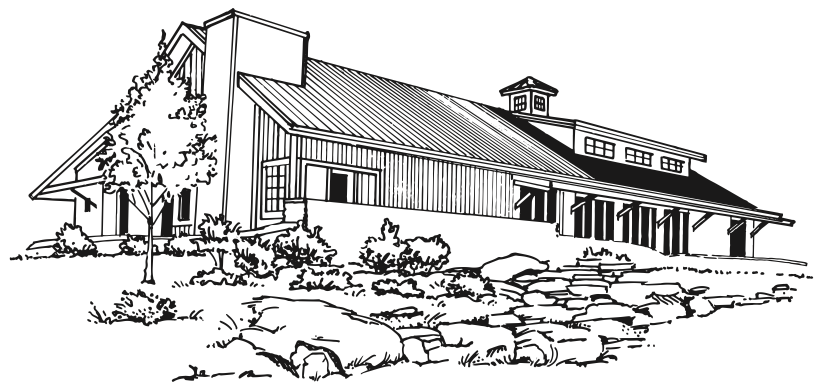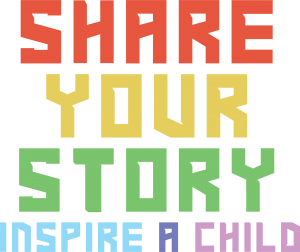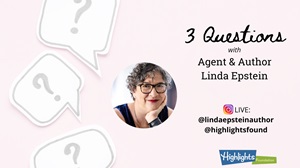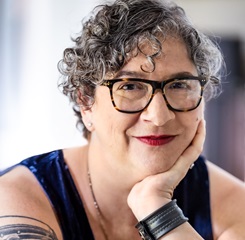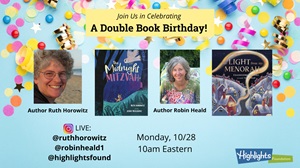Linda Epstein, faculty for Shape Your Story: A 6-Week Novel Intensive, joined Highlights Foundation Social Media Manager Cat Galeano on Instagram Live to talk about the course.
Watch the conversation below. (Please note: closed captions are being added to the video below. When they are finished, you can see them by hovering over the bottom of the video and choosing the “CC” icon.)
Full Transcript:
Cat:
A big hello to our Highlights Foundation family. We’re so happy to have you here with us. For those that may not know me, I’m Cat Galeano, my pronouns are she/her. I’m the social media manager at the Highlights Foundation, joining you from Westchester, New York on the traditional lands of the Seewanoy people. Apart from all the fun things I get to do at Highlights, I myself am a writer and a big reader who is very excited to welcome our friend and faculty Linda Epstein, who will be joining the upcoming Shape Your Story: A 6-Week Novel Intensive Starting May 9th online.
But before we dive in, I, I want to remind our viewers that joining in on any Highlights Foundation sessions, to do so with no hate, no harm and no harassment of any kind.
And now let’s get started. So my first question for you, Linda, is: you are an agent, a freelance editor and a published author. And you’re a poet too, but I’ll focus on the first 3 for this question. You’re a triple threat, who is coming to this course with all those lenses. How does that inform your approach for this course?
Linda:
It’s an interesting question because it just, it doesn’t only inform my approach to the course. That I do all those things informs all of those things. So the fact that I’m an agent and a writer, I bring that to my editing. The fact that I’m a writer and an editor, I bring to my agent thing. So I bring everything, I kind of like bring my, I bring my whole self, really bring my whole self to everything that I do. And in particular for this course, I get to do all the fun things that I like to do in all of my other roles, so.
One of the things that I, that I love is–well, I mean, I talk about story, think about story and the story all the time. I’ll be walking down the street and I’m making up stories, talking on my stories. So I get to do that for people and kind of invite people to do that. And I love that. I get to bring my expertise as to like: what will work in the market, because I’m an agent. I get to bring my empathy, because I’m a writer, so I really understand what it means to be looking at a blinking cursor–do they blink anymore? I don’t even know if they blink–a blank sheet and wonder how am I gonna create something out of nothing. Did I? Does that answer? I don’t know.
Cat:
I mean it’s, I mean yes, because like you come from, you come to this course with so many different experiences and all that feeds the other thing that you do. So that’s unlike other courses where the person teaching perhaps is not one or the other. But in this case, you’re, you’re all of them, which feed into every single part of what you’re teaching.
Linda:
I think so and it’s interesting because I don’t think you can’t teach if you’re not a writer. But if you’re a writer, teaching writing, you really teach it differently. You just really do. You, it’s like teaching something that you’ve experienced and that you’ve grappled with and that you’ve gone through is a different thing than teaching something that you know about intellectually. And after that they…uh…I’m gonna go there, Cat. That actually ties into like writing from your own experience. So, and that’s something that I do talk about in the course because writing from our own experiences makes our writing so much more authentic and true and real. And personal. And teaching writing as a writer for me does the same thing.
Cat:
Well, somebody commented “great answer” so I think you’re on to something.
Linda:
Just so– if anyone is saying anything to me in that word thing, I’m not looking because I’m looking at Cat.
Cat:
Yeah, no worries. I got you. I’m, I’m, I’m like scrolling and looking, so we’re OK. So my second question for you is that this I believe is the 4th time you’ll be teaching this course. And so one of my personal favorite parts is that there are two consultations included–one at the beginning and one at the end. What has been your favorite part of seeing people grow in between those two consultations?
Linda:
That’s a good question. I think this is actually #5 because started as a six month course.
Cat:
Thank you for that correction.
Linda:
I guess in the first consultation… My first one on ones with people is really my opportunity to get to know them as people. One of the things that’s really nice about this course is because I meet with them one to one, we can talk like you and I are talking only not in front of the whole world. Well, and that kind of gives people who might be shy in a group setting or be an introvert or get anxious, or any of those things; that gives them an opportunity to like share who they are with me and for me to get to know them. And I really, really try to make everyone feel comfortable because I know that I get nervous. I mean, I get really nervous about everything, but I get nervous about these things. Like the one-on-one is like: I just want to know who you are. Tell me who you are. That’s the first one.
And then, because of the format of the course, so you know we have every week, we have a a video which is the information, and then we meet live and we get to, people get to ask questions. They get to share from the–because every week there’s also homework–and I ask people, you know what, what did they get from their homework? What, you know, was there any problem–You know, like problems about it? Questions, all that, so they get those questions answered. But then also I really encourage people, and not everyone takes me up, like most people don’t take me up on this and it’s just your mistake. It’s a mistake. You, you’re, you’re paying your money–get what you can from me. I tell people please interact with me via e-mail because on the, on our platform, they can e-mail me and I e-mail them back and most of the time I’m responding to someone either the same day or the next day. Sometimes I don’t do that on the weekends, but. The, the point is: there are multiple points of access that allow them to use me as the teacher in a lovely way.
Then we get to the second consultation, the second one-on-one and what I love about that is… Sometimes, and I tell, I tell everyone, their one-on-one. is their time. They get to, they, they can use it for whatever they want. So maybe someone who’s like interacted with me via e-mail, asked questions all about craft and this and that and the other thing you know…The last thing, we’ll meet one-on-one and they’ll be like. Can I just ask you, like all about the business of publishing? And I’m like: bring it! You know what I mean? Yeah, really. Use it for whatever they want, so I don’t know that, I don’t know that I’m like seeing growth. I think I’m seeing the growth as we go along. You know what I mean? That no, I think, I think, I sort of answered your question, but I changed your question.
Cat:
No, I love it and and I think that’s so important that you touch on the fact like that you are available and that your access is there for the, for the time that this course runs because so often you know, you’re like either scared to ask faculty about like the publishing side, because we’re talking about craft, and you know, the editing side, so it’s like I love that you really stressed on your availability for students during this class. So I really hope people remember that when they sign up to, to interact with you.
Linda:
All the time. And I begged my students: please interact. You know, like ask because there’s no way you, you know, that everyone’s going to get all of their questions right or something’s specific to like what they’re working on. No, I don’t, I’m not like you know, I’m not providing, I do provide a a critique in the beginning. But I’m not providing critique over the course of the of the course. But if someone is like, you know, grappling with a plot problem, they can e-mail me and say: I’m having a plot problem. I’m not going to tell them exactly how to, you know. But I’m going to give them with. well, this is, this is some of the things that I’ve done to like, crack my plot problems. My biggest problem is that I never HAVE a plot, but….
Cat:
But yeah, that’s so important. And thank you again for stressing on that because like you said, someone could be working on something or you like those infamous like in the middle of the night you think of something and you’re like: I need to write this down. And so it’s like e-mail you and reach out because you are there to help. So thank you for stressing that. You sort of touched upon this in your answer, but another cool aspect of this course is that it blends that craft-based learning with work on a specific story. I think that works well in this hybrid online learning model, where they’re listening to recorded lectures in the online classroom, but then you come together live to discuss them. How do you think that makes a difference in the progress people are making on their novels in this course? Because this–just to cut you off for a second–because this model is different from most so that’s why I want to stress that, that this question, I wanted to ask you.
Linda:
So I like this model. I like this, this model came about actually because I have ADHD and it’s really hard for me to present material in a cohesive way with slides and me being cohesive. So I’m…report that and just like get it right and give it to the students. Really, the way that I want it to be instead of like, scattered or imbued with all my anxiety. Right. So’ so first of all, they’re getting, they’re getting that cleanly, right? Now I know that, you know, everyone can go back and watch videos, the videos, you know afterwards, but I think with this model it’s like, it’s very easy for someone to go back and watch this time and time again, if they need to, right?
There’s also, there’s two things. One thing is everyone learns differently, right? So I feel like this model gives multiple points of access to the information. I really want anyone to be able to get something from it. So, you have the videos. You have talking to a human being. Handouts. I have a couple of things that aren’t videos that are just like PowerPoints, right? So there’s like you can read stuff, you can talk to someone and you can watch something. You can listen. So it’s kind of it, it, there’s, there are multiple points of access. And I think that, also, the second thing was: everyone’s coming into the course at a different stage in their writing journey. And in where they are with the manuscript. To the very beginning and just trying to figure out what they’re going to do, to the fully complete manuscript and be like: OK. How do I know if this is good? Or anywhere in between or something else, right? So, so the material that I’m giving really can be used in any way at whatever stage you’re at. If you’re someone who’s like published novels already, you can still take this course because it’s the kind of thing where it’s like: oh,I forgot about that. Oh, I could figure out character in that way, you know. Oh, there’s supposed to be a theme?
Do you know what I mean? It’s just like, like, like, just because someone is published, myself included, doesn’t mean we stop learning, so a published author can, can take this course and get something out of it. Someone who’s right starting, it’s like, well, we’re gonna start with structure and outlining and all that. So, you know, built in because here we go. So I don’t know if that answered the question because I can’t remember the question.
Cat:
It’s OK, but I also think you touched on something really important on the fact that if you are published, if you are established, it’s a great refresher course. But also if you are at the beginning, it’s a great place to start. So and then that leads into the different access points that you mentioned that there’s kind of a plethora of ways to absorb the information. Whether it’s the live one-on-ones with you, the PowerPoints that you and the handouts you add to the classroom or the video lectures themselves, the “lives” with the class. I think that’s so special and so important. All that kind of like mixture of options you have because that allows for anyone for whichever learning style they have, yeah, to absorb that information.
Linda:
I have a student take the same course twice. I was like: Highlights, can you just let her know that she started the course and she was like, oh, I know. I was like, OK. Because you bring something different to the course, you bring something different in like where, what you need. Something different in like the kinds of questions you’re gonna ask everytime you would, you would take the course, so.
Cat:
Of course, whatever project you’re working on will you need, like you said, different things. So awesome that that person took it twice. That is so cool to know that it’s serving someone in different ways. Even though it is essentially the same material, so that is awesome and so cool. So that’s it for my questions. If there’s anything else you’d like to add?
Linda:
Um, I want to tell people that I’ve been fiddling with the idea for a workshop called how to “Kill Your Darlings and Where to Hide the Bodies.” Oh, um, follow me on Instagram because when I figure out how to do this and where to do this, that’s where the information will be. And also I want, oh I wanted to tell people who might be watching, who don’t write for children or teens, this course is not for writers of children and for writers who write for children and teens exclusively. The information is the same. Writing a novel is writing a novel, so if you write for adults, you will get so much out of this course because it’s writing a novel. It’s how to shape your novel, right? The examples that I use throughout the course are mostly children’s literature. And I am developing a version of this for adults where it will be, you know, with adult um…examples…books.
Yeah. So I guess the thing is I want people to like pay attention because I’m like creating a bunch of other stuff. I want: if you haven’t signed up for this course and you think you might want to, please do it because there are, before we started, 8 spots left and I wouldn’t be surprised if a few more people sign up after this. And I think that’s it.
Cat:
Just the jumping off point of what you were saying is there is 8 spots left as of right now. It could change while we finish this conversation, but also at the Highlights Foundation, we offer payment plans, so if that’s something that you need to know, please reach out to us. Always feel free to reach out to us. We want to work with you, so you can get into the courses that you need. That is very important for us to know that we support you and whatever state you are. And that includes if something is a little too higher end for you. So please reach out to us. We want you in the course, especially if it’s Linda’s course that you’re looking to get into because it starts very soon. So please reach out.
Linda:
Were there any questions in all of that, like, rolling stuff?
Cat:
No one asked any questions. There’s a lot of love for us. So lots of love for you, for, for this conversation and for our chat and for the things we’ve shared. So no questions specifically, and if anyone wants to add something, I’ll give you a couple of seconds to type, but in the meantime I will go ahead with my outro: If you’d like to learn more from Linda and dive into that novel you have, join her on May 9th through June 13th for Shape Your Story: A 6- Week Novel Intensive with Author and Agent Linda Epstein. You can register on our website highlightsfoundation.org and lastly you can purchase Linda’s books at our virtual bookshop, powered by bookshop.org. thank you, Linda, for joining us today. And we can’t wait to see you online.
Linda:
Bye Cat. Thanks.
Cat:
Bye, Linda. Thank you for joining us. Bye everyone. Thank you for being here.
